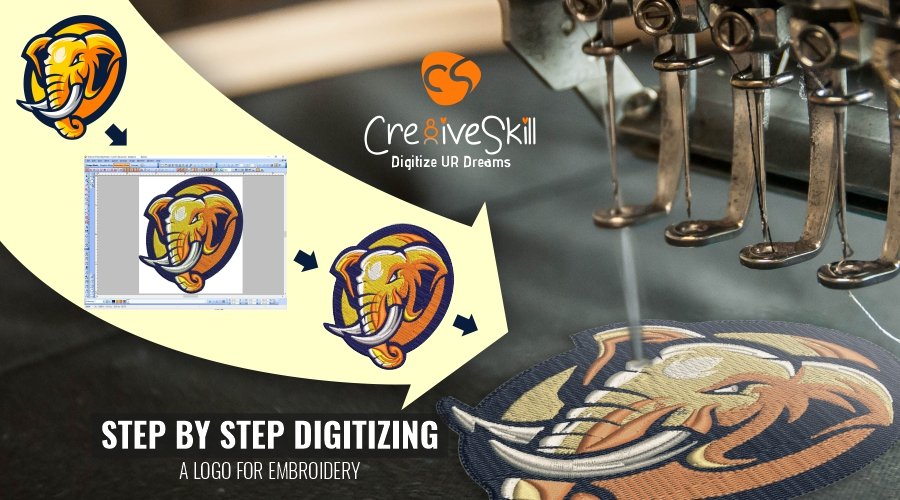Premium Digitizing for Embroidery: Professional Craftsmanship
Wiki Article
Mastering the Needlework Digitizing Refine: Your Ultimate Guide
Embroidery digitizing is a meticulous craft that requires precision and proficiency to translate elaborate designs into electronic styles for maker needlework. As artisans get started on this trip to master the embroidery digitizing process, a comprehensive understanding of the basics establishes the foundation for excellence.
Understanding Needlework Digitizing Basics
Embroidery digitizing fundamentals develop the structure whereupon complex layouts are equated right into machine-readable layouts for precise stitching. This initial action in the embroidery digitizing procedure is crucial for guaranteeing that the final embroidered item is a loyal representation of the initial style. Comprehending embroidery digitizing basics involves understanding essential concepts such as stitch kinds, sew direction, density, underlay, and draw payment.Sew kinds play an important role in determining the aesthetic and textural result of the embroidered design. By picking the proper stitch type, whether it be satin, fill, or running stitch, digitizers can achieve the wanted impact and enhance the total top quality of the needlework. Additionally, stitch instructions influences the flow and dimension of the layout, while thickness identifies the spacing and coverage of the stitches.
In addition, underlay stitching provides security to the design by safeguarding the material and preventing distortion throughout the embroidery procedure. Pull settlement is one more essential factor to consider to combat the natural tendency of textile to contract when sewn. Mastering these needlework digitizing basics is essential for creating professional-quality embroidered items.
Selecting the Right Digitizing Software Program
Selecting the proper digitizing software application is an important decision that significantly influences the effectiveness and top quality of the needlework digitizing procedure. Digitizing for Embroidery. When choosing the best digitizing software application, it is vital to think about elements such as the intricacy of layouts you prepare to develop, the user-friendliness of the software program, the level of customer support provided, and the compatibility with your embroidery deviceThere are different digitizing software application choices readily available in the marketplace, ranging from fundamental programs for novices to sophisticated software program for specialist digitizers. Some prominent options include Wilcom EmbroideryStudio, Hatch Embroidery Software Application, and PulseID. These software provide a large range of tools and functions to assist you produce elaborate designs with ease.
Before choosing, it is advisable to discover the various software program choices with totally free trials or demos to establish which one ideal fits your requirements. Additionally, reviewing testimonials and looking for recommendations from experienced digitizers can give beneficial understandings into the strengths and weak points of each software program bundle (Digitizing for Embroidery). By very carefully examining your requirements and contrasting the features of different digitizing software program, you can make an educated choice that boosts your embroidery digitizing workflow
Digitizing Devices and Techniques

Optimizing Style Settings for Embroidery
Grasping the intricacies of layout settings is essential in attaining ideal outcomes in the embroidery digitizing procedure, structure upon the foundation laid by recognizing digitizing tools and methods. find out here When optimizing style setups for embroidery, it is necessary to consider aspects such as stitch kind, density, rug, draw compensation, and registration. Enrollment setups align various components of the design precisely, keeping overall style honesty.
Troubleshooting Common Digitizing Issues
When coming across usual digitizing issues throughout the needlework process, it is necessary to understand the source and execute efficient remedies immediately. One usual issue is stitch thickness concerns, where stitches may be as well thick, creating the fabric to pucker, or also thin, resulting in spaces in the layout. Adjusting visit the website the stitch density settings in the digitizing software program can aid solve this concern.Another frequent difficulty is string breaks throughout the needlework procedure. This can occur because of different factors such as wrong stress setups, dull needles, or using low-quality thread. Making sure correct upkeep of the embroidery machine, consisting of routine needle adjustments and tension adjustments, can reduce the event of thread breaks.
Moreover, layout enrollment mistakes can result in misaligned components within the embroidery layout. Checking the design placement in the digitizing software program and making needed modifications prior to sewing can aid in preventing this issue. By attending to these usual digitizing issues without delay and effectively, you can ensure a smoother needlework procedure and high-quality finished items.
Verdict
In verdict, grasping the embroidery digitizing process calls for a strong understanding of the fundamentals, the best choice of software program, and expertise of devices and techniques. Optimizing layout settings and troubleshooting usual digitizing concerns are vital steps in ensuring high-quality needlework outcomes. By following these actions click over here faithfully, one can attain accuracy and efficiency in the digitizing process.Report this wiki page